Levelized Cost of Biohydrogen from Steam Reforming of Biomethane with Carbon Capture and Storage (Golden Hydrogen)—Application to Spain
Abstract
:1. Introduction
2. Methodology
2.1. Golden Hydrogen Production and Supply Chain
2.2. Levelized Cost of Hydrogen
2.3. Considerations on CO2
2.4. Cost of Biomethane
2.5. Investment of SMR Plant
2.6. Cost of Operation and Maintenance of SMR Plant
2.7. CO2 Costs
2.8. Assumptions for Validation
2.9. Scenarios Considered
3. Results
3.1. Validation of the Model
3.2. Scenarios Analysis
4. Discussion
5. Conclusions
Author Contributions
Funding
Data Availability Statement
Conflicts of Interest
Abbreviations
| List of Acronyms | ||
| Acronym | Meaning | |
| HyBECCS | Biohidrogen with carbon capture and storage | |
| CAPEX | Capital expenditures | |
| CEPCI | (chemical engineering plant cost index) | |
| CCS | Carbon capture and storage | |
| EU | European Union | |
| GO | Guaranty of origin | |
| HHV | Higher heating value | |
| IEA | International Energy Agency | |
| IEAGHG | International Energy Agency Greenhouse Gas R&D Programme | |
| LCOH | Levelized cost of hydrogen | |
| LHV | Lower heating value | |
| MSW | Municipal solid waste | |
| NG | Natural gas | |
| NIECP | National Integrated Energy and Climate Plan | |
| OPEX | Operation expenditures | |
| SEDIGAS | Spanish Gas Association | |
| SMR | Steam methane reforming | |
| WWTP | Waste water treatment plant | |
| List of Symbols | ||
| Symbol | Meaning | Units |
| CELF | Constant escalation levelization factor | - |
| CHMR | Mass ratio of carbon dioxide to hydrogen | - |
| C | Cost | EUR/kg H2 |
| cNG_cH2 | Ratio of cost of natural gas to hydrogen | - |
| CRF | Capital recovery factor | year−1 |
| η | Efficiency | - |
| HHV | Higher heating value | kWh/Nm3 |
| HMR | Hydrogen-to-methane ratio | - |
| HP | Hydrogen annual production | kg/year |
| INV | Investment | EUR or USD |
| k | Ratio of increase in nominal escalation rate and wacc | - |
| LHV | Lower heating value | kWh/Nm3 |
| M | Molar mass | kg/kmol |
| N | Number of years | year |
| Q | Volume flow rate Nm3/h | Nm3/h |
| r | Nominal escalation rate | - |
| wacc | Weighted average capital cost | - |
| P | Daily hydrogen production | kg/day |
| List of Subscripts | ||
| Subscript | Meaning | |
| bg | biogas | |
| bge | biogas per unit of energy | |
| bm | biomethane | |
| inj | injection | |
| om | operation and maintenance | |
| stg | storage | |
| tax | taxes | |
| tpt | transport | |
| ug | upgrading | |
| x | x-th component of cost | |
References
- European Commission. Repower EU Plan, Brussels 18.5.2022. Available online: https://energy.ec.europa.eu/system/files/2022-05/COM_2022_230_1_EN_ACT_part1_v5.pdf (accessed on 27 January 2024).
- Bortolotti, M.; Collins, P.; Timmermans, M. (Eds.) Clean Hydrogen Monitor, Hydrogen Europe. 2023; Available online: https://hydrogeneurope.eu/wp-content/uploads/2023/10/Clean_Hydrogen_Monitor_11-2023_DIGITAL.pdf (accessed on 9 January 2024).
- Ministry for Ecological Transition and the Demographic Challenge (MITERD). Hydrogen Roadmap: A Commitment to Renewable Hydrogen. 2020. Available online: https://www.miteco.gob.es/es/ministerio/planes-estrategias/hidrogeno.html#:~:text=Hydrogen%20Roadmap%3A%20a%20commitment%20to%20renewable%20hydrogen&text=The%20development%20of%20renewable%20hydrogen,high%20added%20value%20green%20economy (accessed on 29 January 2024). (In Spanish)
- Energy National Secretary. Updating Draft of National Integrated Energy and Climate Plan, MITERD. 2023. Available online: https://www.miteco.gob.es/content/dam/miteco/es/energia/files-1/_layouts/15/Borrador%20para%20la%20actualizaci%C3%B3n%20del%20PNIEC%202023-2030-64347.pdf (accessed on 9 January 2024). (In Spanish)
- IEA. Global Hydrogen Review. 2022. Available online: https://www.iea.org/reports/global-hydrogen-review-2022 (accessed on 29 January 2024).
- Lipman, T. What Will Power the Hydrogen Economy? Present and Future Sources of Hydrogen Energy. University of Cali-fornia-Davis. July 2004. Available online: https://itspubs.ucdavis.edu/download_pdf.php?id=172 (accessed on 29 January 2024).
- Lou, Y.; Fan, Z.; Friedmann, J.; Corbeau, A.; Agrawal, M.; Khatri, A. The Potential Role of Biohydrogen in Creating a Net-Zero World. Columbia Center of Global Energy Policy. January 2023. Available online: https://www.energypolicy.columbia.edu/publications/the-potential-role-of-biohydrogen-in-creating-a-net-zero-world/ (accessed on 29 January 2024).
- Green Hydrogen Coalition. Green Hydrogen Guidebook. 2022. Available online: https://www.ghcoalition.org/guidebook (accessed on 29 January 2024).
- Soler, V.; Linares, J.; Arenas, E.; Romero, J. Hydrogen from Municipal Solid Waste as a Tool to Compensate Unavoidable GHG Emissions, 12CNIT 2022. Available online: https://repositorio.comillas.edu/xmlui/bitstream/handle/11531/66977/CNIT_11_Hydrogen_from_municipal_rev1.pdf?sequence=1&isAllowed=y (accessed on 29 January 2024).
- Feliu, A.; Flotats, X. Los Gases Renovables. Un Vector Energético Emergente. Fundacion Naturgy. 2019. Available online: https://www.fundacionnaturgy.org/publicacion/los-gases-renovables-un-vector-energetico-emergente/ (accessed on 29 January 2024).
- EBA. Biomethane Production Potentials in the EU. Guidehouse. July 2022. Available online: https://www.europeanbiogas.eu/wp-content/uploads/2022/07/GfC_national-biomethane-potentials_070722.pdf (accessed on 29 January 2024).
- SEDIGAS. Estudio de la Capacidad de Producción de Biometano en España. 2023. Available online: https://estudio-biometano.sedigas.es/wp-content/uploads/2023/03/sedigas-informe-potencial-biometano-2023.pdf (accessed on 29 January 2024).
- Rawoof, S.; Kumar, P.; Vo, D.; Subramanian, S. Sequential production of hydrogen and methane by anaerobic digestion of organic wastes: A review. Environ. Chem. Lett. 2020, 19, 1043–1063. [Google Scholar] [CrossRef]
- IEA. CCUS in Clean Energy Transitions, IEA, Paris. 2020. Available online: https://www.iea.org/reports/ccus-in-clean-energy-transitions (accessed on 9 January 2024).
- CCUS-Enabled Production Working Group, Hydrogen UK. CCUS-Enabled Production Report. 2023. Available online: https://iea.blob.core.windows.net/assets/181b48b4-323f-454d-96fb-0bb1889d96a9/CCUS_in_clean_energy_transitions.pdf (accessed on 9 January 2024).
- Sun, X.; Alcalde, J.; Bakhtbidar, M.; Elío, J.; Vilarrasa, V.; Canal, J.; Ballesteros, J.; Heinemann, N.; Haszeldine, S.; Cavanagh, A.; et al. Hubs and clusters approach to unlock the development of carbon capture and storage—Case study in Spain. Appl. Energy 2021, 300, 117418. [Google Scholar] [CrossRef]
- Spanish Geological Survey (IGME). Potential Geological Storages for CO2 in Spain. Available online: https://info.igme.es/almacenesco2 (accessed on 9 January 2024).
- Rosa, L.; Mazzotti, M. Potential for hydrogen production from sustainable biomass with carbon capture and storage. Renew. Sustain. Energy Rev. 2022, 157, 112123. [Google Scholar] [CrossRef]
- Moioli, E.; Schildhauer, T. Negative CO2 emissions from flexible biofuel synthesis: Concepts, potentials, technologies. Renew. Sustain. Energy Rev. 2022, 158, 112120. [Google Scholar] [CrossRef]
- Lefranc, L.; Linares, J.I.; Santos, A.M.; Arenas, E.; Martín, C.; Moratilla, Y. The role of golden hydrogen in the decarbonising of urban buses. In Proceedings of the ECOS 2023—36th International Conference on Efficiency, Cost, Optimization, Simulation and Environmental Impact of Energy Systems, Las Palmas de Gran Canaria, Spain, 25–30 June 2023. [Google Scholar]
- Yagüe, L.; Linares, J.I.; Arenas, E.; Romero, J.C. Bio-hydrogen with CCUS (golden hydrogen) as decarbonisation tool in hard-to-abate industrial sectors. Application to tile sector in Spain. In Proceedings of the 13th National and 4th International Conference in Engineering Thermodynamics, Castellón de la Plana, Spain, 29 November–1 December 2023. [Google Scholar]
- Full, J.; Geller, M.; Ziehn, S.; Schliess, T.; Miehe, R.; Sauer, A. Carbon-negative hydrogen production (HyBECCS): An exemplary techno-economic and environmental assessment. Int. J. Hydrogen Energy 2024, 52, 594–609. [Google Scholar] [CrossRef]
- European Commission. Towards an Ambitious Industrial Carbon Management for the EU, COM (2024) 62 Final, Strasbourg, 6.02.2024. Available online: https://eur-lex.europa.eu/legal-content/EN/TXT/?uri=COM%3A2024%3A62%3AFIN (accessed on 16 February 2024).
- Tumara, D.; Uihlein, A.; Hidalgo González, I. Shaping the Future CO2 Transport Network for Europe, Joint Research Centre, European Commission. 2024. Available online: https://publications.jrc.ec.europa.eu/repository/handle/JRC136709 (accessed on 16 February 2024).
- Morante, J.R.; Andreu, T.; García, G.; Gullera, J.; Tarancón, A.; Torrell, M. Hydrogen. Energy Vector of a Decarbonised Economy. Naturgy Foundation. 2019. Available online: https://www.fundacionnaturgy.org/publicacion/hidrogeno-vector-energetico-de-una-economia-descarbonizada/ (accessed on 9 January 2024). (In Spanish).
- Leguijt, C.; Nieuwenhuijse, I.; Jaspers, D.; Jongsma, C.; Beeftink, M.; Baltac, S.; Wilson, M.; O’Sullivan, C.; Mattos, A. Low-Carbon Hydrogen from Natural Gas: Global Roadmap, IEA Greenhouse Gas R&D Programme. 2022. Available online: https://documents.ieaghg.org/index.php/s/YKm6B7zikUpPgGA?path=%2F2022%2FTechnical%20Reports#pdfviewer (accessed on 9 January 2024).
- ENAGAS. Guarantees of Origin Website. Available online: https://www.enagas.es/en/technical-management-system/general-information/guarantees-origin/ (accessed on 9 January 2024).
- Barlow, H.; Shahi, S.; Loughrey, M. State of the Art: CCS Technologies 2023. Technical Report, Global CCS Institute. 2023. Available online: https://www.globalccsinstitute.com/wp-content/uploads/2023/10/State-of-the-Art-CCS-Technologies-2023_09_Final.pdf (accessed on 9 January 2024).
- de Dios, J.C.; Martínez, R. The permitting procedure for CO2 geological storage for research purposes in a deep saline aquifer in Spain. Int. J. Greenh. Gas Control 2019, 91, 102822. [Google Scholar] [CrossRef]
- Bejan, A.; Tsatsaronis, G.; Moran, M. Thermal Design & Optimization; John Wiley & Sons: Hoboken, NJ, USA, 1996. [Google Scholar]
- EMBER. Carbon Price Tracker. Available online: https://ember-climate.org/data/data-tools/carbon-price-viewer/ (accessed on 9 January 2024).
- GASNAM. Map of Biomethane Production Plants in Spain. Available online: https://gasnam.es/terrestre/mapa-de-plantas-de-produccion-de-biometano/ (accessed on 29 January 2024).
- Techno-Economic Evaluation of SMR Based Standalone Hydrogen Plant with CCS. IEAGHG Technical Report 2017-02. February 2017. Available online: https://ieaghg.org/exco_docs/2017-02.pdf (accessed on 9 January 2024).
- Itul, A.; Diaz Rincon, A.; Eulaerts, O.D.; Georgakaki, A.; Grabowska, M.; Kapetaki, Z.; Ince, E.; Letout, S.; Kuokkanen, A.; Mountraki, A.; et al. Clean Energy Technology Observatory: Carbon Capture Storage and Utilisation in the European Union—2023 Status Report on Technology Development, Trends, Value Chains and Markets, Publications Office of the European Union, Luxembourg. 2023. Available online: https://publications.jrc.ec.europa.eu/repository/handle/JRC134999 (accessed on 9 January 2024).
- Energy National Secretary. Roadmap of Biogas, MITERD. 2022. Available online: https://www.miteco.gob.es/content/dam/miteco/es/energia/files-1/es-es/Novedades/Documents/00HR_Biogas_V6.pdf (accessed on 9 January 2024). (In Spanish)
- Trading Economics Website. EU Natural Gas. Available online: https://tradingeconomics.com/commodity/eu-natural-gas (accessed on 9 January 2024).
- IEA. Is Carbon Capture Too Expensive? IEA, Paris. 2021. Available online: https://www.iea.org/commentaries/is-carbon-capture-too-expensive (accessed on 9 January 2024).
- IRENA. Making the Breakthrough: Green Hydrogen Policies and Technology Costs. International Renewable Energy Agency. Abu Dabi. 2021. Available online: https://www.irena.org/-/media/Files/IRENA/Agency/Publication/2020/Nov/IRENA_Green_Hydrogen_breakthrough_2021.pdf (accessed on 16 February 2024).
- Maxwell, C. Cost Indices. Available online: https://toweringskills.com/financial-analysis/cost-indices/#cepci-2001-to-present (accessed on 16 February 2024).

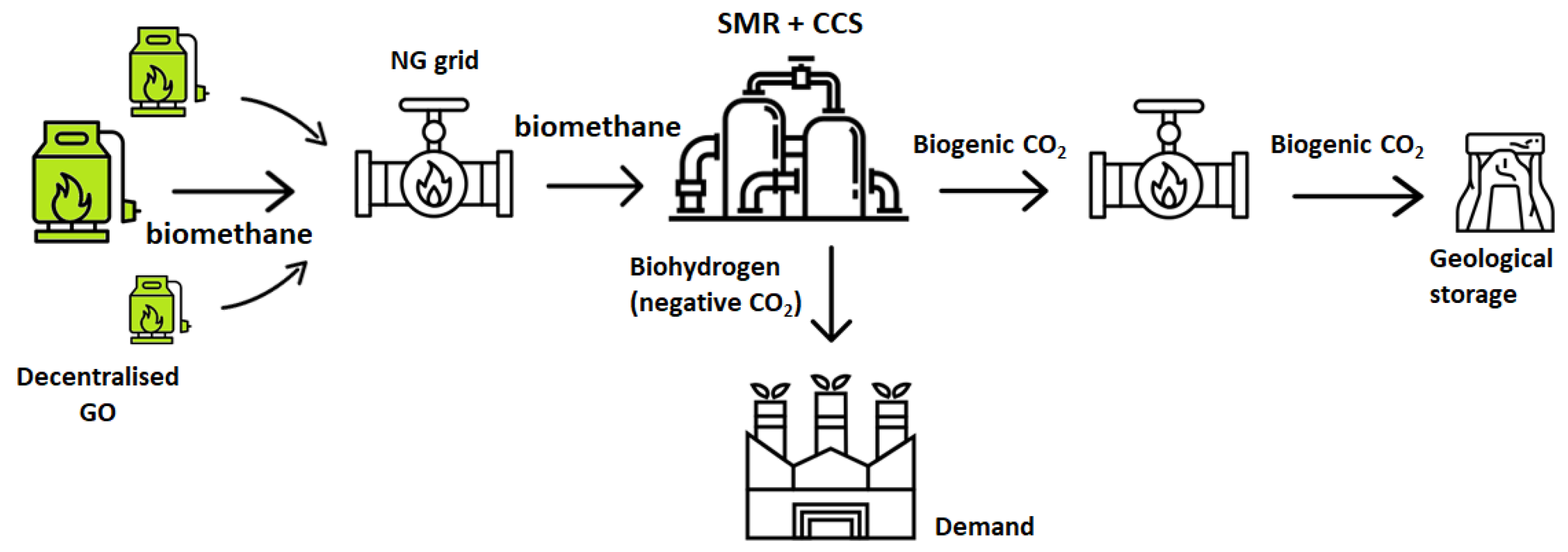
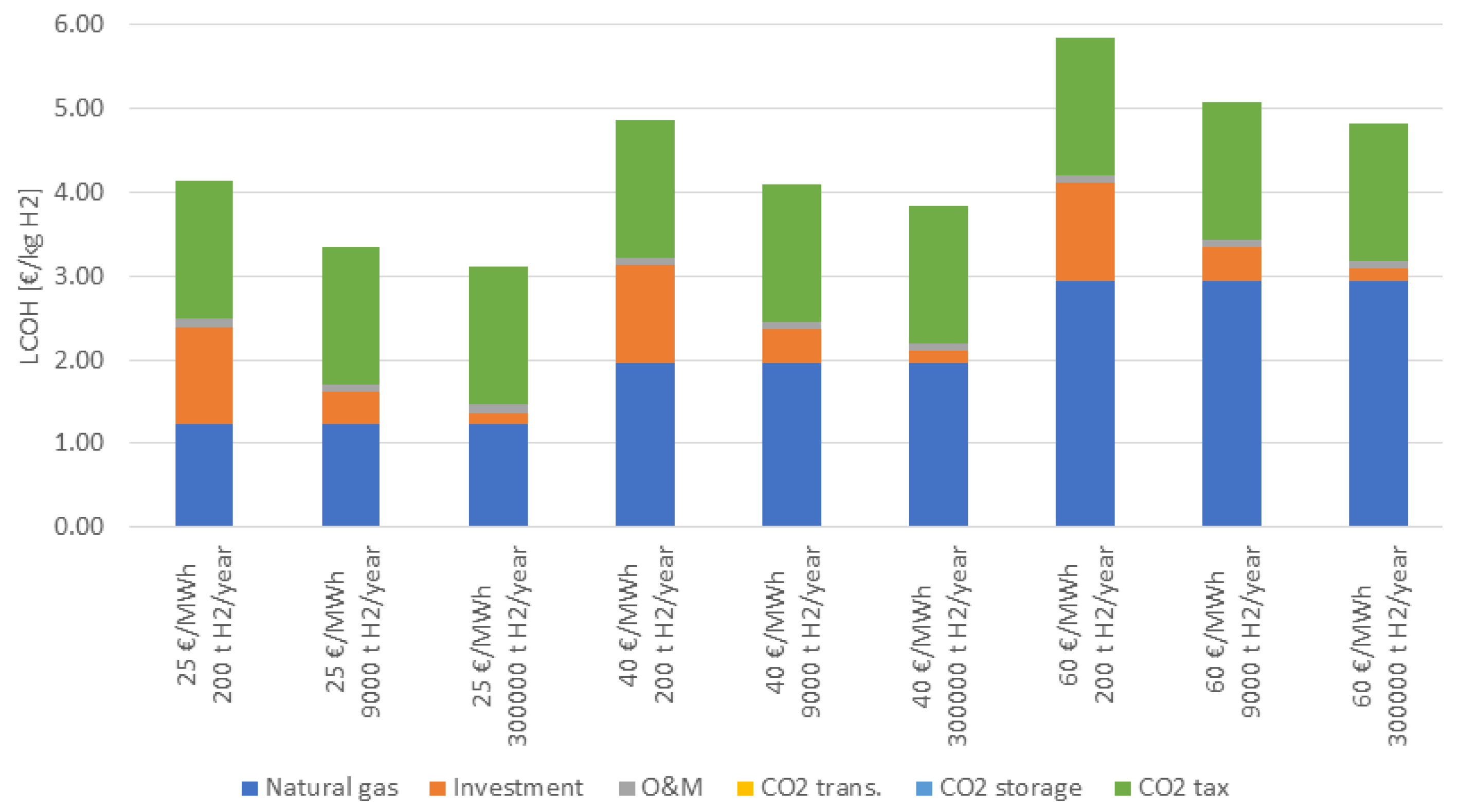
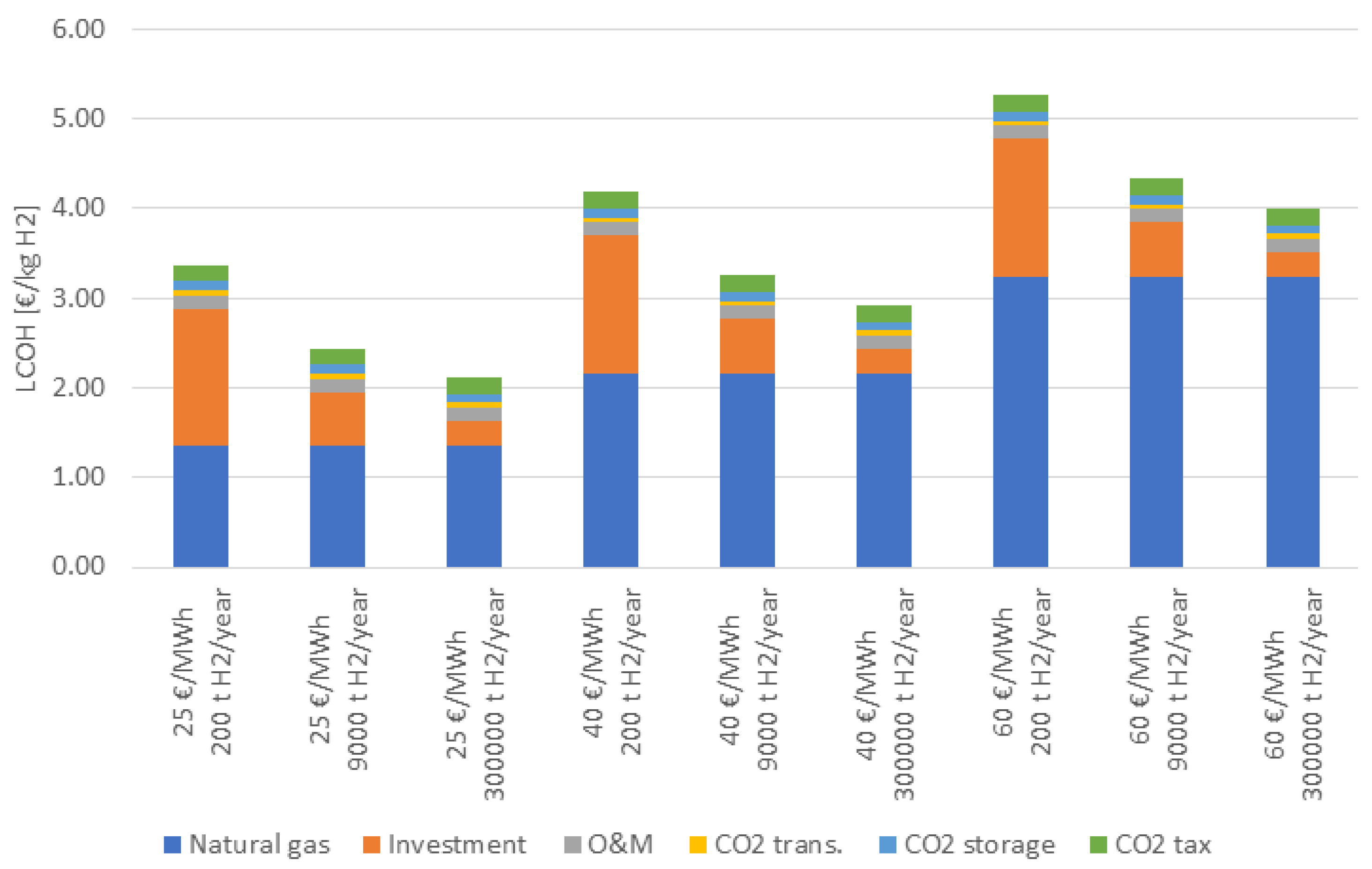
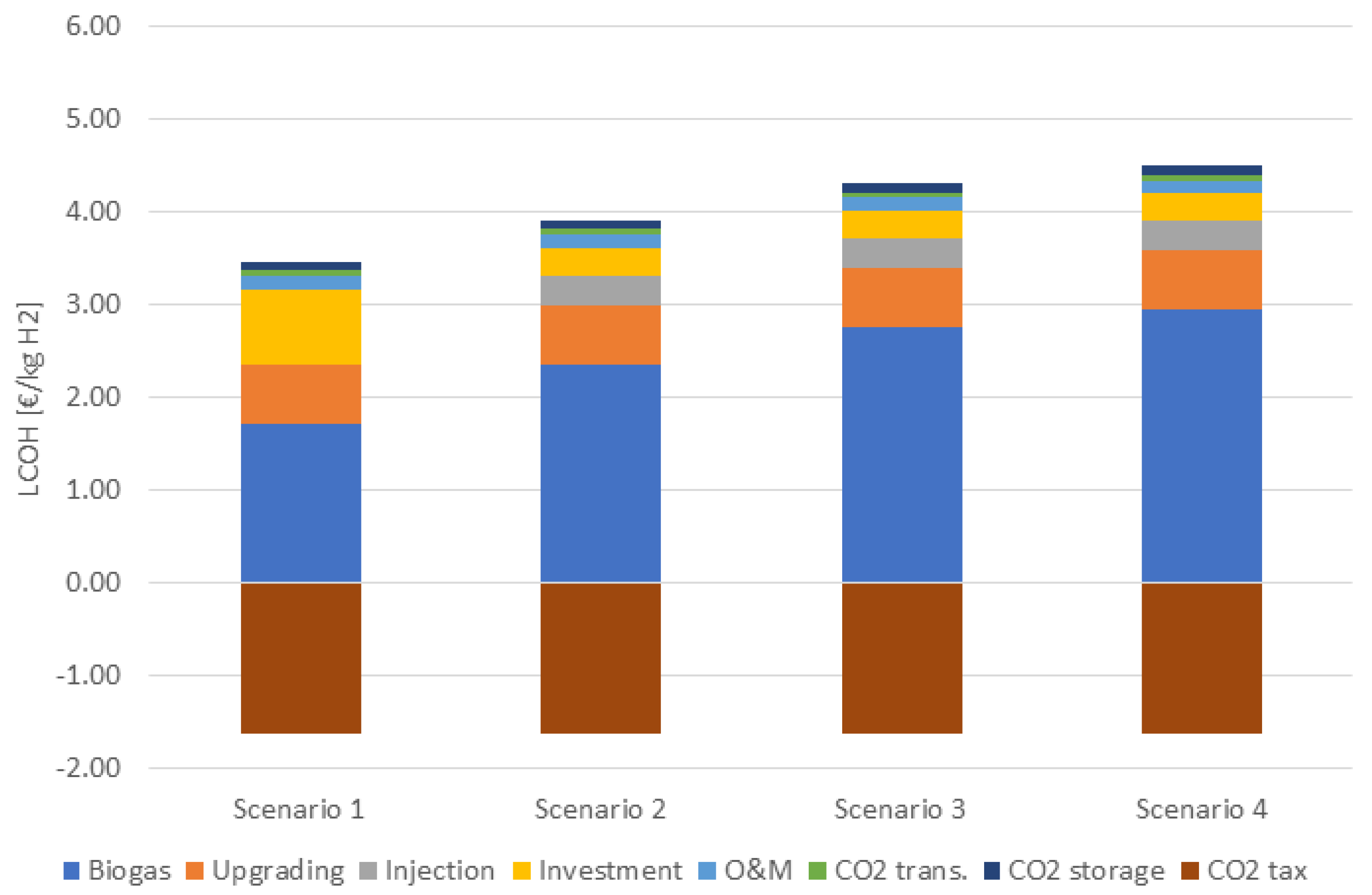
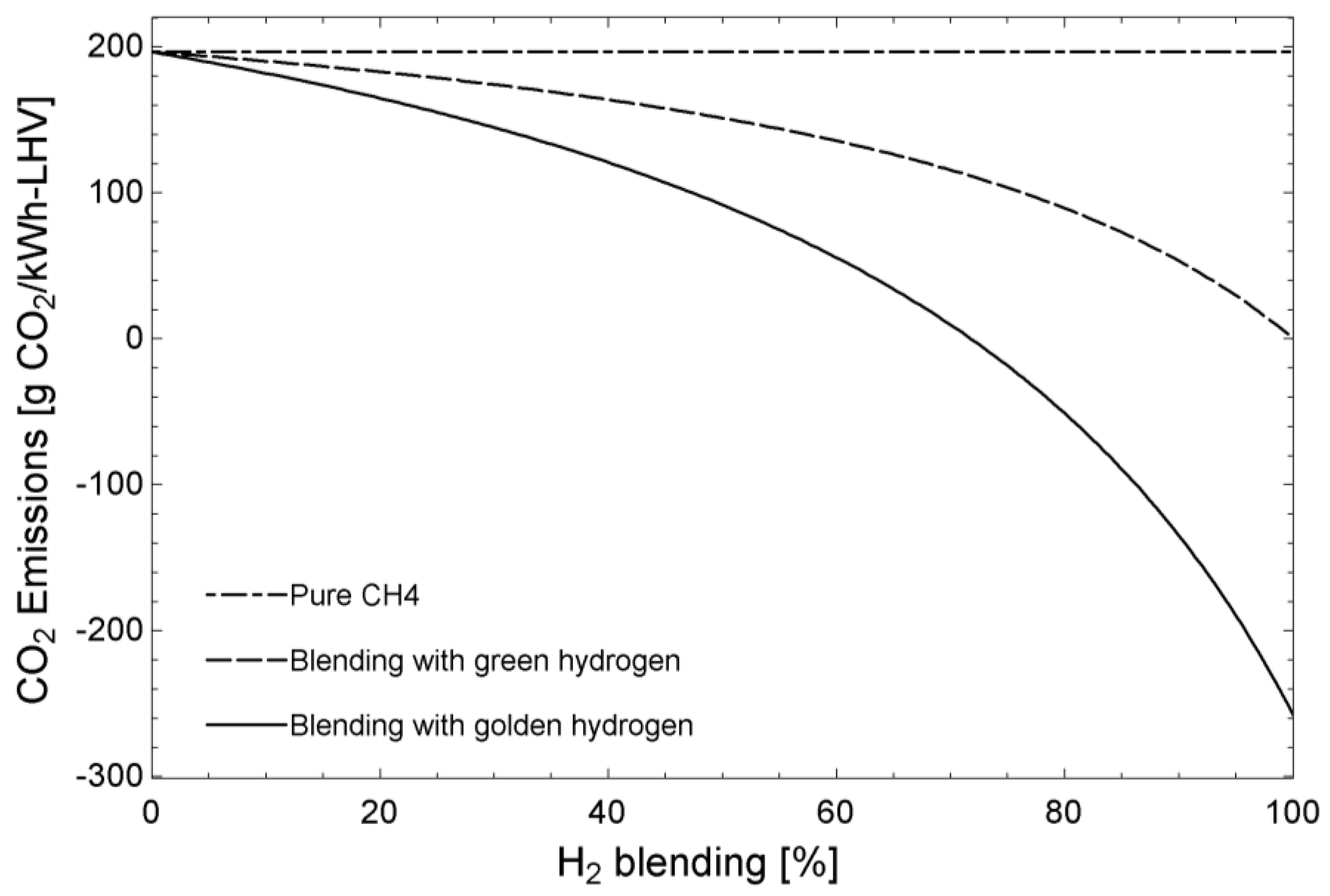
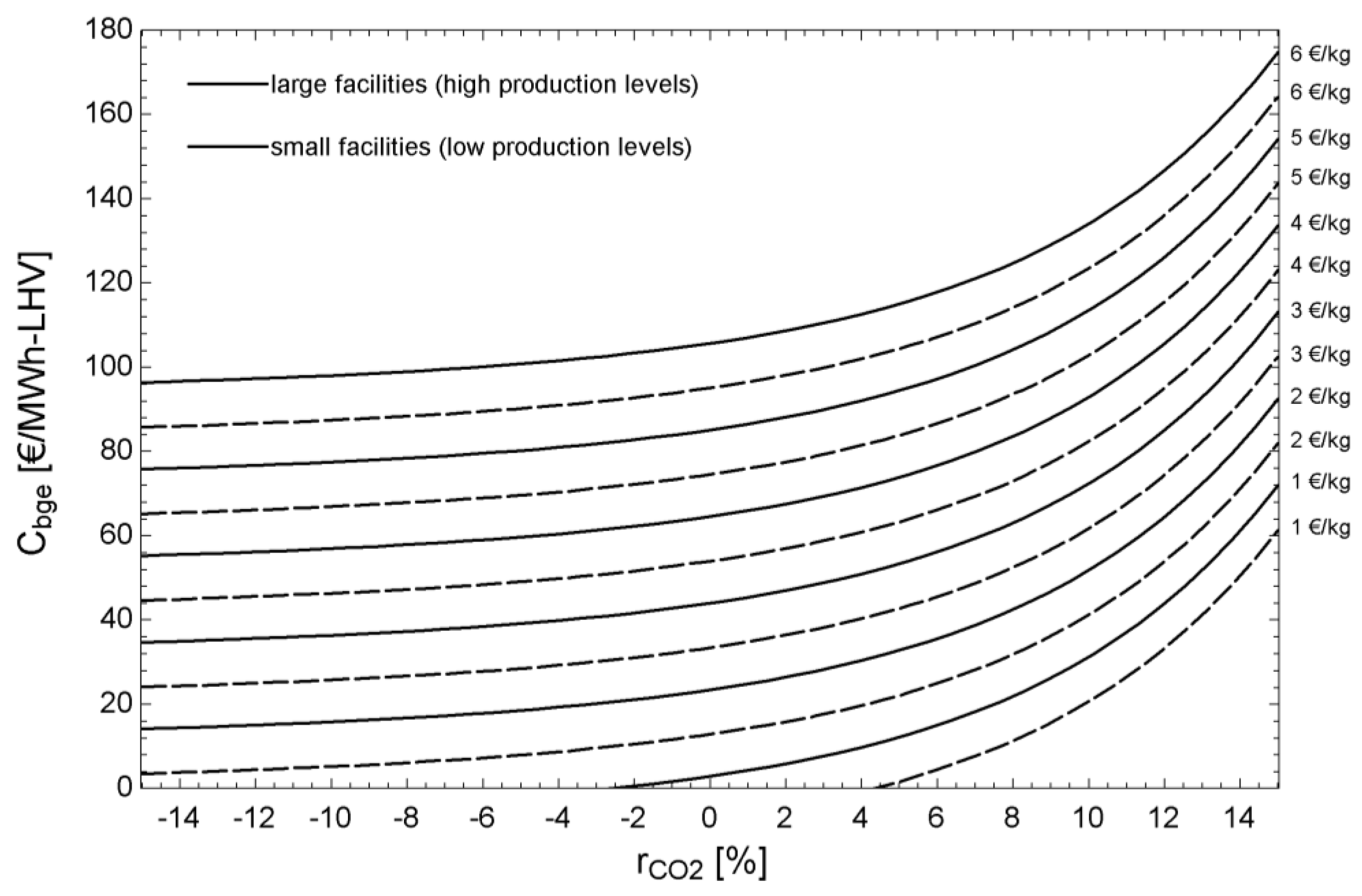
| Substrate | [p.u.] | HMR | CHMR | H2 Production | CO2 Captured |
|---|---|---|---|---|---|
| Without CCS | 0.759 | 2.52 | 8.74 | 20.36 | 0 |
| With CCS | 0.691 | 2.29 | 0.96 | 18.54 | 8.64 |
| Substrate | Cost (EUR/MWh-LHV) |
|---|---|
| Biodegradable waste in a sanitary landfill | 6–10 |
| Organic fraction of municipal solid waste | 30–40 |
| Wastewater treatment plant (WWTP) sludge | 30–40 |
| Cereal stubble | 45–55 |
| Corn (whole plant) | 65–75 |
| Pig manure | 65–75 |
| Volume flow rate of biogas (Nm3/h) | 200 | 500 | 1000 | 2000 |
| Cost of upgrading (EUR/MWh-LHV) | 18–20 | 14–18 | 11–14 | 9–12 |
| Volume flow rate of biogas (Nm3/h) | 200 | 500 | 1000 | 2000 |
| Cost of injection (EUR/MWh-LHV) | 15–20 | 8–12 | 5–7 | 2–4 |
| Hydrogen Production (kg/day) | LCOH (USD/GJ) | Natural Gas Cost (USD/GJ) | (%) | cNG_cH2 (%) |
|---|---|---|---|---|
| 480 | 24.75 | 6.16 | 60 | 41.48 |
| 24,000 | 9.73 | 4.27 | 72 | 60.95 |
| 609,000 | 5.5 | 3.0 | 81 | 67.34 |
| 609,000 | 6.6 | 3.9 | 81 | 72.95 |
| 609,000 | 6.85 | 4.1 | 81 | 73.89 |
| Hydrogen Production (kg/day) | LCOH (USD/GJ) | Natural Gas Cost (USD/GJ) | (%) | cNG_cH2 (%) |
|---|---|---|---|---|
| 24,000 | 12.41 | 4.27 | 72 | 47.79 |
| 609,000 | 7.20 | 3.0 | 81 | 51.44 |
| Hydrogen Production (P) (kg/day) | INVnoCCS (USD2003) |
|---|---|
| 480 | 3,846,130 |
| 24,000 | 50,448,185 |
| 609,000 | 605,214,704 |
| 609,000 | 601,471,108 |
| 609,000 | 602,510,996 |
| Hydrogen Production (kg/day) | cNG_cH2 (%) | INVCCS_2003 (USD) | INVCCS_2003 − INVnoCCS_2003 (USD) |
|---|---|---|---|
| 24,000 | 47.79 | 86,032,633 | 35,584,449.54 |
| 609,000 | 51.44 | 1,177,984,909.19 | 572,770,204.78 |
| Concept | SMR without CCS (EUR/year) | SMR with CCS (EUR/year) |
|---|---|---|
| Direct labour | 2,280,000 | 2,580,000 |
| Administrative | 991,714 | 1,323,590 |
| Insurance | 1,709,520 | 3,053,280 |
| Maintenance | 2,564,280 | 4,579,920 |
| Total | 7,545,514 | 11,536,790 |
| Substrate | Potential (TWh) Scenario 1 | Potential (TWh) Scenario 2 | Potential (TWh) Scenario 3 | Potential (TWh) Scenario 4 | Biogas Cost Assumed (EUR/MWh-LHV) |
|---|---|---|---|---|---|
| Agricultural waste | 4.5 | 24.8 | 24.8 | 50–60 * | |
| Manure | 0.9 | 25.5 | 25.5 | 70 | |
| Intermediate crops | 0.0 | 11.8 | 58.8 | 70 | |
| Forest waste | 0.0 | 27.7 | 27.7 | 70 | |
| Industry waste | 2.2 | 6.4 | 6.4 | 50 | |
| Organic fraction MSW | 7.92 | 1.8 | 7.9 | 7.9 | 35 |
| WWTP sludge | 0.6 | 3.0 | 3.0 | 35 | |
| Landfill gas | 1.1 | 8.8 | 8.8 | 8 | |
| Total | 7.92 | 11 | 116 | 163 |
| Substrate | Potential (TWh) | Total Hydrogen Production (t/day) | Number of SMR Plants | Unitary Hydrogen Production (kg/day) |
|---|---|---|---|---|
| Scenario 1 | 7.92 | 402.3 | 55 | 7397 |
| Scenario 2 | 11 | 558.7 | 1 | 558,740 |
| Scenario 3 | 116 | 5892 | 10 | 589,216 |
| Scenario 4 | 163 | 8280 | 14 | 591,393 |
Disclaimer/Publisher’s Note: The statements, opinions and data contained in all publications are solely those of the individual author(s) and contributor(s) and not of MDPI and/or the editor(s). MDPI and/or the editor(s) disclaim responsibility for any injury to people or property resulting from any ideas, methods, instructions or products referred to in the content. |
© 2024 by the authors. Licensee MDPI, Basel, Switzerland. This article is an open access article distributed under the terms and conditions of the Creative Commons Attribution (CC BY) license (https://creativecommons.org/licenses/by/4.0/).
Share and Cite
Yagüe, L.; Linares, J.I.; Arenas, E.; Romero, J.C. Levelized Cost of Biohydrogen from Steam Reforming of Biomethane with Carbon Capture and Storage (Golden Hydrogen)—Application to Spain. Energies 2024, 17, 1134. https://doi.org/10.3390/en17051134
Yagüe L, Linares JI, Arenas E, Romero JC. Levelized Cost of Biohydrogen from Steam Reforming of Biomethane with Carbon Capture and Storage (Golden Hydrogen)—Application to Spain. Energies. 2024; 17(5):1134. https://doi.org/10.3390/en17051134
Chicago/Turabian StyleYagüe, Luis, José I. Linares, Eva Arenas, and José C. Romero. 2024. "Levelized Cost of Biohydrogen from Steam Reforming of Biomethane with Carbon Capture and Storage (Golden Hydrogen)—Application to Spain" Energies 17, no. 5: 1134. https://doi.org/10.3390/en17051134







